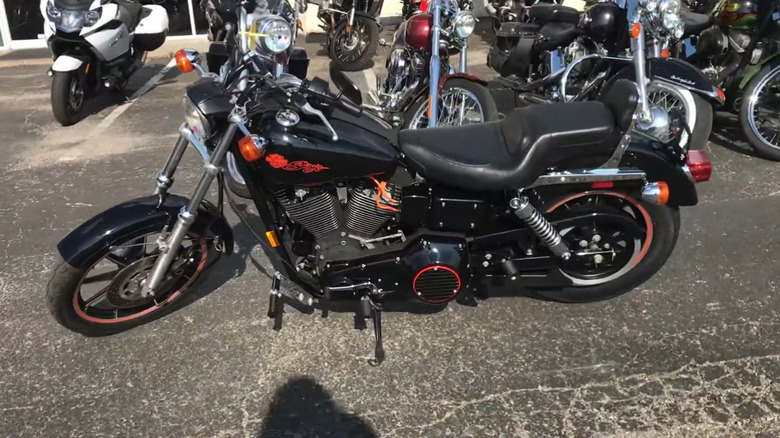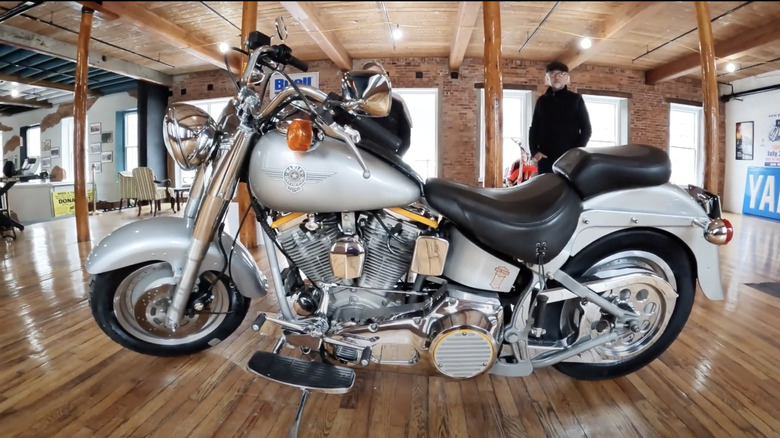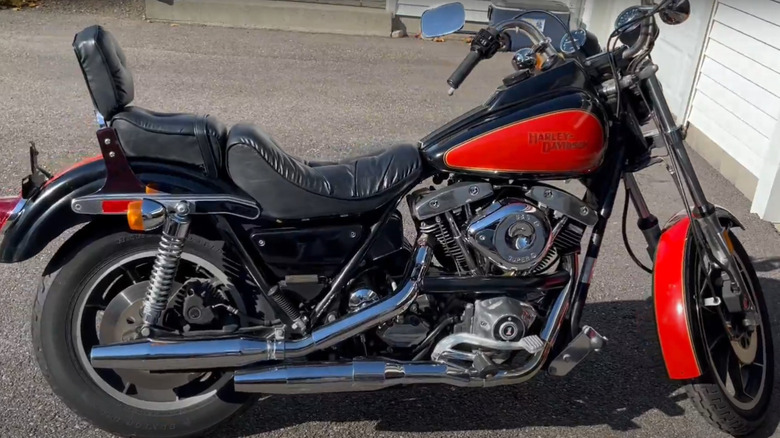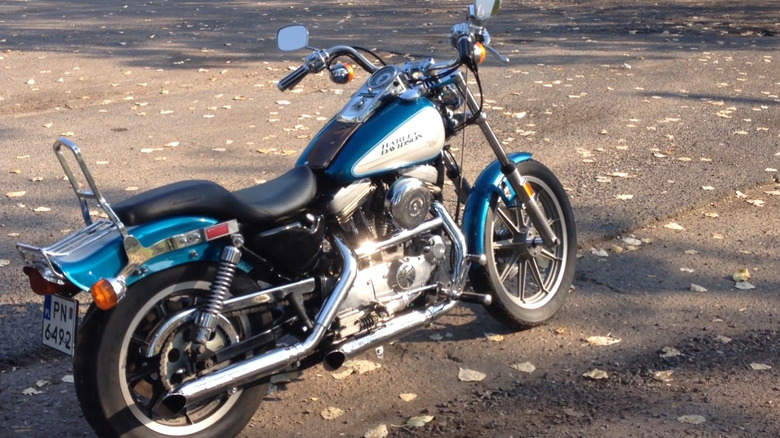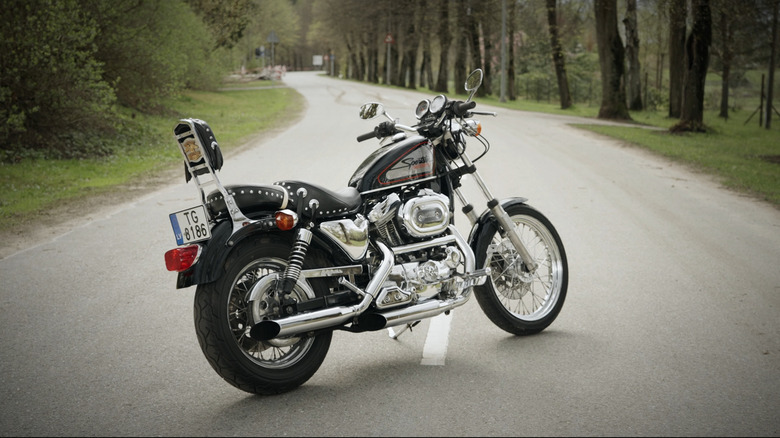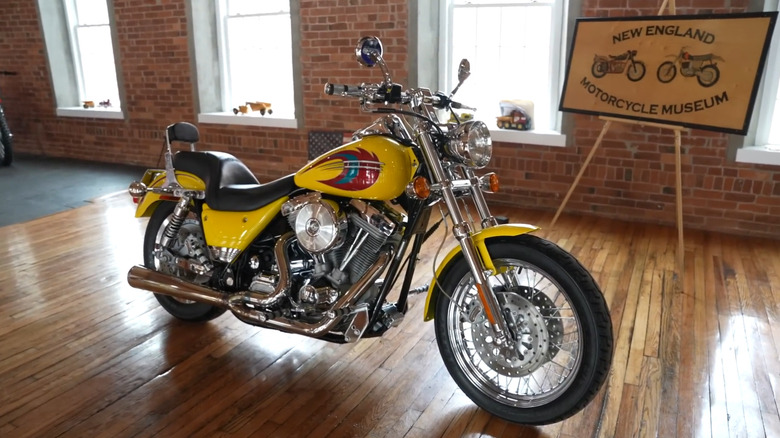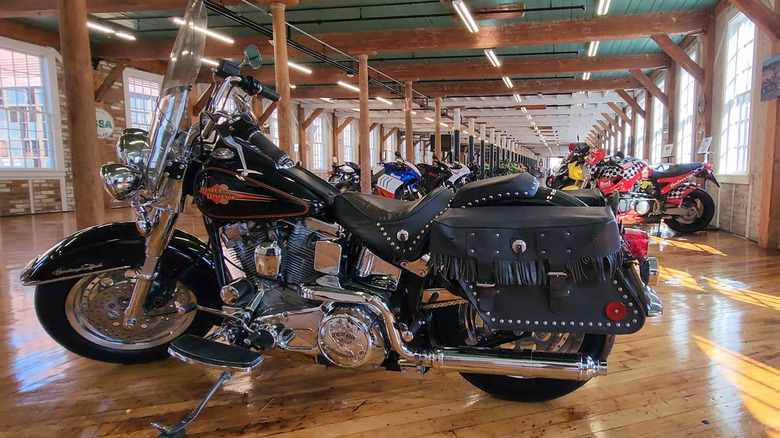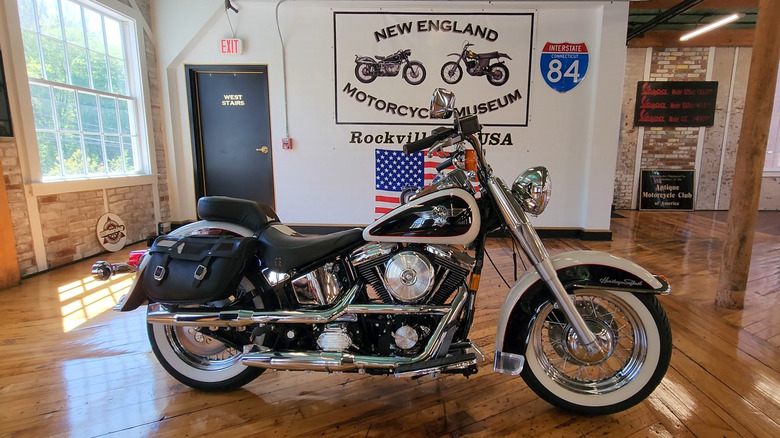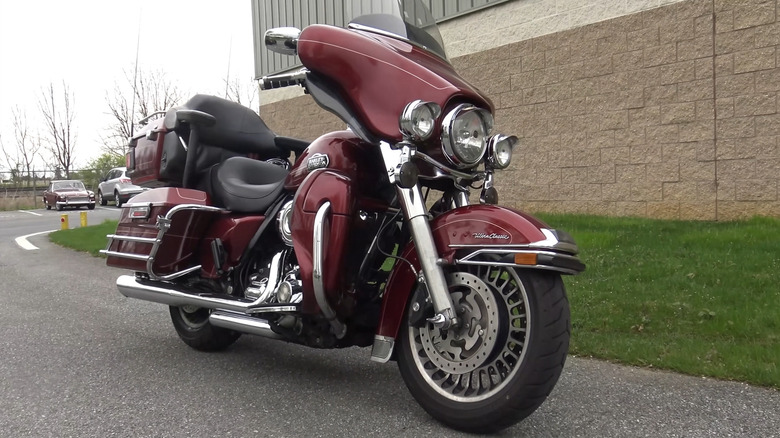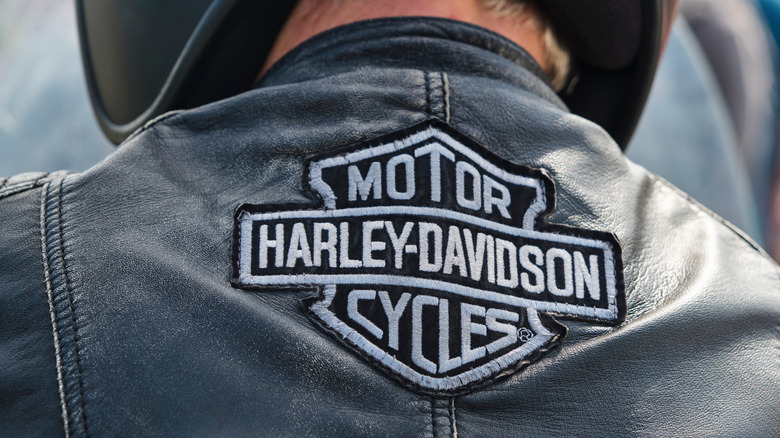10 Of The Best Harley-Davidson Models With The Evo Engine
In the middle of the 1980s, legendary motorcycle manufacturer Harley-Davidson was in a full blown crisis: numbers were down, morale was nonexistent, and innovation was a pipe dream. AMF had bought out Harley in 1969, and the owner's decisions had run the much-beloved motorcycle company into the ground, eventually resulting in a labor strike. However, in 1981 a group of 13 investors (with Willie Davidson) banded together, pooled their money, and bought Harley-Davidson back. They immediately set about trying to reverse the damage of the previous decade and a half.
The first major decision this group of new owners made was to revive the glory days of big Harley V-twin engines. THis led to the birth of the legendary "Evo" engine line of bikes. Evo, short for evolution was a performant change, being an "evolution" or upgrade of the existing Shovelhead engine that had been produced since 1966. When the Evo released in 1984, it became evident that this was one of the most powerful Harley-Davidson engines ever made. It most prominently featured in Harley's Softail line, and would go on to power some of the best-looking Harley-Davidson Softail models, until its replacement by the Twin Cam engine in 1999. Here are 10 of the best Harley-Davidson models that came with the Evo engine.
Dyna Glide Sturgis (1990-1991)
The first item on our list is the 1991 Harley-Davidson FXDB, more commonly known as the Dyna Glide Sturgis. Almost 25 years old, it's a collectors item in many enthusiasts' books, and for good reason. When this particular generation was introduced, its launch coincided with the 50th anniversary of the famous Sturgis bike rally that is held each year in the Black Hills of South Dakota. The first Harley-Davidson Sturgis ever released was in 1982, but that one was powered by the Shovelhead engine we mentioned earlier. The 1990-1991 variant came with the new 80 cubic inch Evolution engine.
Harley really leaned into the Black Hill rally theme with the 1991 model, giving it all-black bodywork with orange accents. The blacked out look was further enhanced by the chrome details on the Dyna Sturgis — or rather, the lack thereof. You see, while most Harley-Davidson motorcycles tend to go heavy on the Chrome, the 1991 FXDB limited chrome to accents on the fork and tips of the exhaust pipes. The gauges for the bike — normally mounted on top of the fuel tank in chrome housings — were set in all-black trim. Even the Evolution engine was black rather than chrome, with orange accents peeking through here and there — truly one of the most stylish Harley-Davidson models of all time.
Softail Fat Boy (1990)
The next motorcycle on our list is one of the earliest touring motorcycles to come with "fat boy" tires, and it looks awesome. The bike debuted in 1990-1991 — the same model year as the Dyna Sturgis we just introduced you to — and was designed by one of the people who'd bought the Harley-Davidson brand back from AMF, Willie G. Davidson. He was assisted in the design process by a man named Louie Netz — and what a design it was. Power came from an 82 cubic-inch version of the Evolution engine with a Keihin carb that churned out 67 hp and 72 lb-ft of torque.
Some people like to claim that the Fat Boy name was a veiled insult to the Japanese (to show that the Americans were now back on par with the Japanese bikes) with the name being a combination of "Fat Man" and "Little Boy," the names of the two nuclear bombs dropped on Hiroshima and Nagasaki back in World War II, but this is untrue — the Fat Boy moniker was given to the bike solely because of its wide design. The Fat Boy roared into public view (literally) through its appearance in the 1991 film "Terminator 2: Judgement Day," with Arnold Schwarzenegger blasting into view with "Bad to the Bone" by George Thorogood & The Destroyers playing in the background — and ever since that scene, every Harley fan ever would have wanted to own a Fat Boy.
Softail Heritage Classic (1995-1997)
There have been many Softail Heritage Classic variants over the years, but the specific one we want to include on our list of the best Harleys is this one, the FLSTC 1340. In case you were wondering, Harley uses abbreviations like FXST to describe their models, with FLSTC being the Softail classic line — hence the STC at the end. Anyway, this particular generation was in production from 1995 to 1997, making it one of the last Softail models — one of the last Harley's in fact — that would come with the Evo engine, as the Twin Cam would release in 1999, and the Revolution engine would make its debut in 2001.
In terms of design, this generation of FLSTC bikes got studded-leather seats, laced wheels, full-coverage fenders, a puzzlingly small windshield, a passenger backrest, and the iconic "shorty" dual exhaust. Also, chrome was absolutely everywhere on the Softail Heritage Classic, from the forks and wheels, to the engine cover and exhaust pipes, you didn't have to look far to find a gleam of chrome on this bike. In terms of power specifications, it was almost the same as the two models from above: 58 hp from a 45-degree air cooled 80 cubic-inch V-twin Evo engine, paired to a very engaging five-speed manual transmission. All in all, a fantastic bike that was criminally underrated at the time in favor of flashier models like the Sportster, but one that will live on in the Harley-Davidson history books forever.
FXR Super Glide II (1982-1994)
Next up is one of the most iconic and popular Harleys that turns heads everywhere it goes — if you picture of a Harley-Davidson motorbike, you're probably thinking of this one. The FXR Mk ii Super Glide was produced between 1982 and 1994, which means it would have used the 80 cubic-inch shovelhead engine, at least initially. However, it transitioned over to an 82 cubic-inch version of the Evo engine toward its later model years. The FXR was Harley's phoenix, meant to show the world that American high displacement (for the time anyways) engines could also be sporty and fun to ride in things other than a straight line.
A man named Erik Buell — yes, the same one as the Buell motorcycle brand that is now back from the dead — was responsible for a lot of the redesign and engineering behind the FXR. As with the other models of the time, the redesigned Evo engine managed to churn out a respectable 50 hp and 67 lb-ft of torque, and was paired with the standard five-speed manual transmission that most Harley bikes were running with at the time — a real icon. The price points were also not too audacious, with early models retailing for $6,999 and late models going for around $10,300.
Apparently, Buell was once even approached by some Hells Angels who thanked him for "making Harley a rider's bike again" after the FXR Super Glide II was launched.
Sportster 1200 (1984-1988)
This one didn't actually use the same 82-cubic-inch version of the Evolution engine that all the other Harleys on our list used so far. As we mentioned, the Evo engine had two main variants: a big rumbling V-twin, and a more refined Sportster version, with this bike using the latter and also being its namesake. It was one of the largest displacement Harley sports-ish bikes of all time: among H-D's few attempts at a road-cum-touring model, one that is successful enough that it's still being produced today.
Introduced in 1984, the Sportster line began with the Sportster 1000 (which actually used a 997cc "troublehead" engine, as it is jokingly called), with a 1,100cc Evo engine being offered from 1986 onward. In 1988, the Evo engine got another size bump to 1,200cc, and that's the version we want to put on this list: a 1,200cc touring bike that could do everything you'd want a Harley to do — and you can snag one today for around $3,100. No matter what anyone says about it being overpriced for an almost-40 year old bike — it's a hell of a lot of motorbike for the money. If you're feeling flush however, you can get a brand-new 2025 Sportster S that ticks all the Harley boxes — performance, comfort, looks — with the only problem being the base MSRP of $15,999, and that's before destination fees and surcharges.
Sportster 883 (1986-1988)
Continuing with the Sportster Line, we present the little brother of the Sportster 1200 from above: the Sportster 883, one of the earliest Harley models to use the "Sportster" variant of the Evo engine. As you know by now, the Sportster ran with the 997cc "troublehead shovelhead" engine from 1984 to 1986, when it got the new Evolution engine. When the Evo was introduced to the Sportster line, buyers could choose from two engine sizes: 1200cc, and the smaller, more nimble 883cc version, the latter of which was so different from its bigger sibling that we consider it a whole different motorcycle altogether.
The 883cc version was vastly more popular than its larger 1,100cc sibling, with the smaller unit selling about 10,348 units in 1986 alone — the year of the engine debut — and the bigger 1,100cc Evo engine Sportsters only netting about 4,100 sales. Other than the displacement sizes, the Evolution engine was just like the other models, being a 45-degree V-twin layout, with four-cycle overhead valves, four cams to match, and a butterfly carb. The smaller displacement engine made 40 hp and 62 lb-ft of torque, with the larger unit producing a not-insignificant-for-the-time 60 hp and 64 lb-ft of torque. However, a major difference was that the Sportster (both the 883 and 1,100) came with a four-speed transmission until 1991, when they switched over to the five-speed, with both specifications being equally desirable today.
CVO FXR4 (2000)
We can't have a list of Harley Evo motorcycles and not include the FXR lineup, specifically the 2000 model year FXR4. This motorcycle was the absolute last one to come with an Evo engine, which is one of the reasons why it is sought after nowadays. People often incorrectly assume that the Softails from 1999 were the last models to get the Evo engine, but this is false, as the 2000 FXR4s continued to be produced with the Evo engine, though it was discontinued the same year in that line of bikes as well.
Fun fact: The dude who bought the last FXR4 didn't even know he'd stumbled onto a piece of Harley history. The story goes, he just pulled up to the dealer who had sold him his Sportster and Electra Glide, assuming they'd have an FXR hanging about (which they did), and he came home with it. When he sat down to have a clean, and removed the engine cover, he found signatures from the technicians who'd assembled it. He then wrote to Harley-Davidson asking about the provenance of his particular FXR4's VIN, and received a letter from Willie G. Davidson himself confirming the bike's significance. Talk about luck. Power for the 2000 FXR4 came from the Evo engine, with this particular model year making 49 hp and 63 lb-ft of torque at 2,400 rpm, giving the rider good grunt at low revs — something that every bike should do.
Softail Classic (1984)
We've already introduced you to the 2000 CVO FXR4, which was the last bike to come with an Evo engine — but that begs the question — which was the first Harley to introduce this iconic power plant? Well, the first, or at least one of the first five models to come with the then-brand new Evolution engine is this one: the 1984 Softail Classic. Back when it was introduced, it was revealed to much fanfare, even warranting dry-ice smoke effects at the curtain pullback, and with good reason. This bike featured the first big displacement engine from Harley-D since the acquisition, and what an engine it would go on to be.
It was mounted with a 45-degree gap between them, which was the signature of house Milwaukee, and came with aluminum heads, and a newer, narrower (58-degree) valve induced angle, but still remained an overhead, long-bore engine. Given the model code of "FXST," where "ST" presumably stood in for "Soft Tail," this was also one of the first Harley models that would hide the rear suspension underneath fenders, giving the bike the comfort of full suspension, but also the clean lines and design of a hardtail motorbike. And the rest, as they say, is history — that's how one of the most iconic Harley-Davidson motorcycles was born.
Heritage Nostalgia (1993)
The second-last Harley-Davidson bike on our list was actually built to be a commemorative edition — it's one of the most sought after Softail Harley-Davidsons of all time, and rarely comes onto the market. We're talking about the 1994 Heritage Classic Nostalgia edition, with model code FLSTN, sometimes called the "Moo Glide" or "Cowglide" Nostalgia. It had spoked chrome wheels, upon which were mounted the widest whitewall tires you've ever seen, and natural cowhide trimmings on the seat and right-mounted saddle bag, which is where the nickname "Cowglide" comes from.
This particular model was released as part of Harley-Davidson's 90th anniversary celebrations, alongside four other models. The bike shared its frame with the FL (and thus FX) line of Harley motorcycles, and was powered by the now-mature 1,337cc Evolution engine that, in this bike, managed to churn out 57 hp and was paired to the five-speed manual transmission most other heavy Harleys were running with at the time. Units maintained with their original specifications will all have the same white and birch paint scheme, with whitewall tires and chrome everything — seriously — even the tail lights had chrome on them (that no one would possibly see when you were on the move). The Cowglide was excessive in every way imaginable — and Harley didn't care. They were celebrating nearly a century of being the best in the game, and this was their way of showing it.
Harley-Davidson Ultra-Classic Electra Glide FLHTCU (1990)
And lastly, the most Harley-Davidson model of them all: the 1990 FLHTCU. Also known as the Ultra Classic Electra Glide, the bike's flared bodywork, signature colors, chrome accenting, and imposing road presence are all iconic now. The particular generation we're putting on the list is the one made between 1989 and 1990, which launched as the halo offering from Milwaukee house. It came with the (by now) trusty 45-degree four-cam V-twin 1,337cc Evolution engine, making 50 hp and 69.3 lb-ft of torque, while being paired to a five-speed manual that had a belt final drive and a Mikuni carb.
Make no mistake — this was not a fast bike by any standards, because even the legendary Evo engine wouldn't be able to propel this 741 pound behemoth to very high speeds, and the 5.3 gallon fuel tank, though substantial, would probably get used up very quickly — but none of that mattered. None of that mattered because this was a true "for-the-riders" motorcycle, and arguably was the model that popularized the bat wind styling at the front. If there was one motorcycle to have, it would be the 1990 FLHTCU, with its lumbar-support seats, rear trunk, passenger backrest, secure and lockable side storage, built-in four speaker radio-cum-cassette player, and even a C/B intercom system.
Methodology
To put a bike on this list was troublingly hard work, as the 80's and 90's were some of Harley-Davidson's golden years, when models like the Softail and Sportster dominated the lineups. To quantify a particular motorcycle as being among the "best" ever made, it had to meet some conditions. And of course, each model on the list had to primarily come with the Evolution engine as standard, even if another engine was an option. If a particular model ticked all those boxes, we shortlisted it, and then we selected the most iconic, innovative, or best-selling bikes from that shortlist.
Also, we had to include the first and the last bikes to come with the Evolution engine of course — which were the 1984 Softail Classic and the 2000 CVO FXR4 respectively. And that's it — we've come to the end of our list of the best Harley-Davidson motorcycles that came with the Evo engine. These are the models that dragged Harley up from the pit that the previous owners had dug it into, and brought the iconic American brand back to life — and now you know the 10 best ones.

